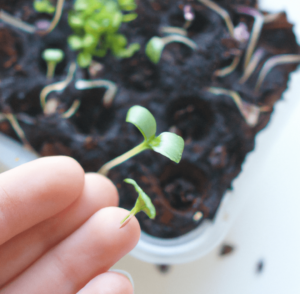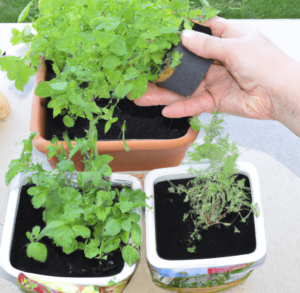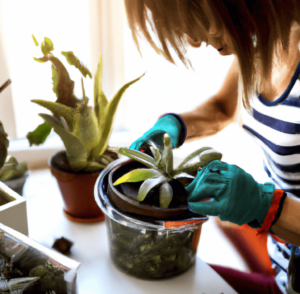Fruit gardens are a type of garden that are specifically dedicated to growing a variety of fruits. From classic favorites like apples and oranges, to exotic options like pomegranates and passionfruit, fruit gardens can provide a delicious and nutritious source of produce for individuals, families, and communities. In this article, we will delve into the world of fruit gardens, covering topics such as the types of fruit that can be grown, the process of growing and maintaining a fruit garden, the role of the gardener, and the importance of soil and farming techniques. Whether you are a seasoned green thumb or a beginner looking to start your own fruit garden, this article will provide valuable insights and information.

Gardening
Gardening is the practice of growing and cultivating plants, flowers, and vegetables in a garden, allotment, or small plot of land. It can be a relaxing and rewarding hobby, as well as a practical way to produce fresh fruit and vegetables for your family.
There are many different types of gardening, including fruit and vegetable farming, ornamental gardening, and hydroponics. Whether you are a beginner or an experienced gardener, there are always new things to learn about the art and science of growing plants.
Some basic tips for gardening include choosing the right location for your garden, preparing the soil, and selecting the right plants for your climate and soil type. It is also important to water and fertilize your plants regularly, and to control pests and diseases.
Gardening can be a fun and educational activity for people of all ages. It allows you to connect with nature and learn about the natural world, as well as providing a sense of accomplishment and pride in the fruits of your labor.
Vegetable Gardening 101
Vegetables are an important part of a healthy diet and can be grown in a variety of ways. Unlike fruit, which is typically grown on trees or bushes, vegetables are typically grown in the ground and require specific conditions in order to thrive.
In order to grow vegetables, it is important to choose the right soil. The soil should be well-draining and rich in nutrients, as this will help your vegetables grow strong and healthy. It may also be necessary to add compost or other organic matter to the soil to improve its quality.
Gardening can be a fun and rewarding hobby, but it does require some knowledge and effort. If you are new to gardening, there are many resources available to help you get started. You can learn about different types of vegetables, how to care for them, and how to troubleshoot common issues. There are also many online resources, books, and classes available that can teach you the basics of vegetable gardening.
Garden Basics: Understanding Plants, Soil, and Growing
A garden is a space where plants are grown and nurtured, often for the purpose of producing flowers, vegetables, or fruit. A gardener is someone who tends to a garden, performing tasks such as planting, watering, and weeding.
Plants are living organisms that use photosynthesis to convert sunlight into energy. They are typically grouped into categories based on their characteristics, such as annuals, perennials, shrubs, and trees. Each type of plant has specific requirements for soil, water, and sunlight, which a gardener must consider when choosing what to plant in their garden.
Soil is the foundation of a healthy garden. It is a complex mixture of organic matter, minerals, and microorganisms that supports plant growth. Different types of plants have different soil requirements, so it is important for a gardener to select the right soil for their plants. The pH level of the soil, as well as its nutrient content, can also impact plant growth.
Growing plants requires a combination of knowledge and patience. A gardener must understand the needs of their plants and be prepared to provide the proper care, such as watering and fertilizing, to ensure that their plants thrive. With the right techniques and a bit of luck, a gardener can enjoy a bountiful harvest of flowers, vegetables, or fruit from their garden.
Section: Pollination for Fruit Growing in the Backyard
Pollination is an essential process for many fruit varieties to grow and produce healthy fruit. In the backyard, it is important to understand the pollination requirements of the fruit plants that you have planted. Some fruit plants, such as apples and pears, are self-fertile, meaning that they do not require pollinators to produce fruit. Other fruit plants, such as cherries and blueberries, are self-incompatible, meaning that they require pollinators to fertilize the flowers and produce fruit.
There are many different types of pollinators, including bees, butterflies, moths, and hummingbirds. These pollinators are attracted to flowers by the nectar and pollen that they produce. In order to ensure that your fruit plants are adequately pollinated, it is important to provide a diverse range of flowering plants in your backyard. This will attract a variety of pollinators and increase the chances of successful pollination.
It is also important to consider the timing of pollination. Some fruit plants have specific blooming periods during which they must be pollinated in order to produce fruit. Make sure to plant a variety of flowering plants that bloom at different times, so that there is always a source of nectar and pollen available for pollinators throughout the growing season.
By understanding the pollination requirements of your fruit plants and providing a diverse range of flowering plants in your backyard, you can help ensure a successful fruit harvest.
Growing Fruits Gardens
Fruit, plants, and other forms of vegetation require specific conditions in order to thrive. One important factor is the type of soil in which they are planted. Different types of soil can provide varying levels of nutrients and support for the roots of the plants. A gardener or farmer must be knowledgeable about the characteristics of the soil in their area and choose plants that are suitable for those conditions.
In addition to selecting the right plants for the soil, a gardener or farmer must also consider other factors such as sunlight, water, and temperature in order to ensure that the plants receive the proper care and support. This may involve techniques such as watering, fertilizing, pruning, and pest control in order to keep the plants healthy and productive.
Farming, whether on a small scale in a backyard garden or on a large scale on a farm, requires a significant amount of knowledge, skill, and hard work. However, the reward of growing and harvesting healthy and delicious fruit, vegetables, and other plants can be well worth the effort.
Pears
Pears are a type of fruit that are closely related to apples, berries, and cherries. Like these other fruits, pears are grown on trees and are a popular and nutritious addition to many diets. There are hundreds of different varieties of pears that vary in size, shape, and color. Some common varieties of pears include Anjou, Bartlett, Bosc, and Comice.
Pears are typically grown in temperate regions with moist, well-draining soil and a long growing season. They require a lot of care and attention, including regular pruning, fertilizing, and pest control. Pears are often grown in orchards alongside other types of fruit trees, such as apples and cherries.
Pears are a nutritious and tasty fruit that can be eaten fresh, cooked, or baked in a variety of dishes. They are high in fiber, vitamins, and minerals and can be enjoyed as a snack, in salads, or as a component of a larger meal.
Extending Your Fruit Garden and Vegetable Plants
Gardening can be a fun and rewarding hobby, and one way to enhance your garden is by adding fruit and vegetable plants. These plants not only add visual interest to your garden, but they also allow you to grow your own fresh produce right at home. There are many different types of fruit and vegetable plants that you can choose from, depending on your climate and the space available in your garden. Some popular options include tomatoes, peppers, cucumbers, berries, and herbs. With a little planning and care, you can successfully grow a wide variety of fruit and vegetable plants in your garden.
Plants: Basics for Successful Growing Fruit Gardens
Plants are living organisms that belong to the kingdom Plantae. They are characterized by their ability to produce their own food through the process of photosynthesis, in which they convert sunlight into energy using chlorophyll found in their leaves.
One important aspect of plant growth is the type of fruit it produces. There are many different varieties of fruit, ranging from apples and oranges to tomatoes and peppers. Each type of fruit has its own unique set of characteristics and requires specific growing conditions.
In order to successfully grow a plant, it is important to consider the type of soil it needs. Different plants have different soil requirements, and it is important to choose a soil that will support the growth of the specific plant you are trying to cultivate. Additionally, the season in which a plant is grown can also impact its growth. Some plants are annuals, which means they complete their life cycle within one growing season, while others are perennials, meaning they can grow and produce fruit for many seasons.
Overall, proper care and attention to the specific needs of a plant, including the right type of soil and season for growth, can lead to successful cultivation and a bountiful harvest.
Understanding the Role of Seed in Planting and Growing a Crop
Planting a crop begins with selecting the right type of seed for the desired plant, as well as the climate and growing season in your location. The seed is the starting point for any plant, containing all the necessary genetic information to grow and eventually produce fruit or flowers.
Before planting, it is important to consider the size and type of the seed, as well as the depth and spacing at which it should be planted. Some seeds, such as beans and peas, should be planted shallowly, while others, like carrots and onions, should be planted deeper. Proper planting technique is important to ensure that the seed has the best chance to germinate and grow into a healthy plant.
Once planted, the seed begins to grow roots, which anchor the plant in the soil and allow it to access water and nutrients from the surrounding environment. The roots also help the plant to withstand environmental stresses, such as extreme temperatures or pests.
The growing season, or the time of year when a particular type of plant is able to thrive, is also an important factor to consider when planting a crop. Different plants have different requirements for sunlight, temperature, and moisture, so it is important to choose a seed that is well-suited to the conditions in your area.
Overall, the seed plays a crucial role in the success of a crop. By understanding the specific needs of the seed and the conditions in which it will be grown, you can ensure that your plants have the best chance to thrive and produce a bountiful harvest.
Plants
Plants are living organisms that belong to the kingdom Plantae. They are essential for life on Earth as they produce oxygen and serve as a food source for many animals. There are many different types of plants, including fruit-bearing plants, which produce edible fruits, and non-fruit-bearing plants, which may produce flowers or other types of vegetation.
Soil is the foundation for plants to grow and thrive. It is made up of a combination of organic matter, minerals, and water, and it provides the nutrients that plants need to grow. Different types of soil are suitable for different types of plants, so it is important for gardeners to choose the right soil for the plants they are growing.
Space is another important factor to consider when growing plants, as different plants have different space requirements. Some plants need a lot of room to spread out and grow, while others are more compact and can be grown in smaller spaces.
Gardens are areas where plants are grown and cultivated for various purposes, such as for food, medicine, or decoration. Gardeners are individuals who tend to and care for plants in a garden, making sure they are watered, fertilized, and protected from pests and diseases. Gardening can be a relaxing and rewarding hobby for people of all ages.
Planning a Fruit Garden in Your Backyard
If you have a backyard and are interested in growing your own fruit, there are a few things to consider before getting started.
One important factor to consider is your location. Different types of fruit thrive in different climates and soil types. For example, if you live in a place with hot, dry summers like Utah, you might consider planting drought-tolerant fruit trees like peaches. On the other hand, if you live in a more humid climate, you might want to look into growing berries or citrus fruits.
Another thing to consider is the size and layout of your backyard. If you have a small space, you might want to focus on growing fruit in containers or raised beds. If you have a larger backyard, you might consider planting a variety of fruit trees and bushes.
Before planting any fruit trees or bushes, it’s important to prepare the soil by adding compost or other organic matter to improve drainage and fertility. You should also plan out the layout of your garden, taking into account the mature size and spacing requirements of the fruit trees or bushes you plan to plant.
With a little bit of planning and care, you can enjoy fresh, homegrown fruit from your own backyard!

Growing Cherries in Your Garden
Cherries are a delicious and nutritious fruit that can be grown in a home garden. They are a type of stone fruit, like peaches and plums, and are related to strawberries. Cherry plants require a sunny location with well-draining soil and need to be protected from strong winds. They can be grown in containers or in the ground and can be trained to grow as a tree or as a bush.
When planting cherry trees, it is important to choose a variety that is suited to your climate. Some cherries, like sweet cherries, require a long growing season and may not be suitable for cooler climates. Sour cherries, on the other hand, are more cold-hardy and can be grown in a wider range of climates.
Cherries require regular watering and fertilization to produce healthy fruit. They also need to be pruned annually to encourage new growth and to remove any damaged or diseased branches. With proper care, cherry plants can produce fruit for many years.
In addition to the traditional red cherries, there are also varieties that produce yellow, black, or white fruit. No matter what type of cherry you choose to grow, they can be a delicious and rewarding addition to your home garden.
Harvesting Fruit in the Summer
Harvesting fruit refers to the process of collecting and gathering the fruit that has grown on a plant. During the summer months, many types of fruit reach maturity and are ready to be harvested. There are many different varieties of fruit that can be grown and harvested, including apples, berries, citrus fruits, stone fruits, and tropical fruits.
To prepare for the harvest season, fruit trees and plants must first be planted and cared for during the growing season. This typically involves providing the plants with adequate water, sunlight, and nutrients, as well as pruning and training the plants to grow properly. Once the fruit has matured, it can be picked by hand or with the use of specialized equipment.
After the fruit has been harvested, it may be used fresh or it may be processed in some way, such as being canned, frozen, or dried. Harvesting fruit is an important part of food production and can provide a source of income for farmers and growers.
Bottom Line: Fruits Gardens
Fruit gardens are a type of garden that are specifically dedicated to growing fruit. They can provide a delicious and nutritious source of produce for individuals and communities. The process of growing and maintaining a fruit garden involves choosing the right fruit to grow, preparing the soil, and using proper farming techniques. The role of the gardener is also important in ensuring the success of a fruit garden.
If you’re interested in what are the fruit gardens, you may also be interested in demonstration gardens and vegetables gardens.







